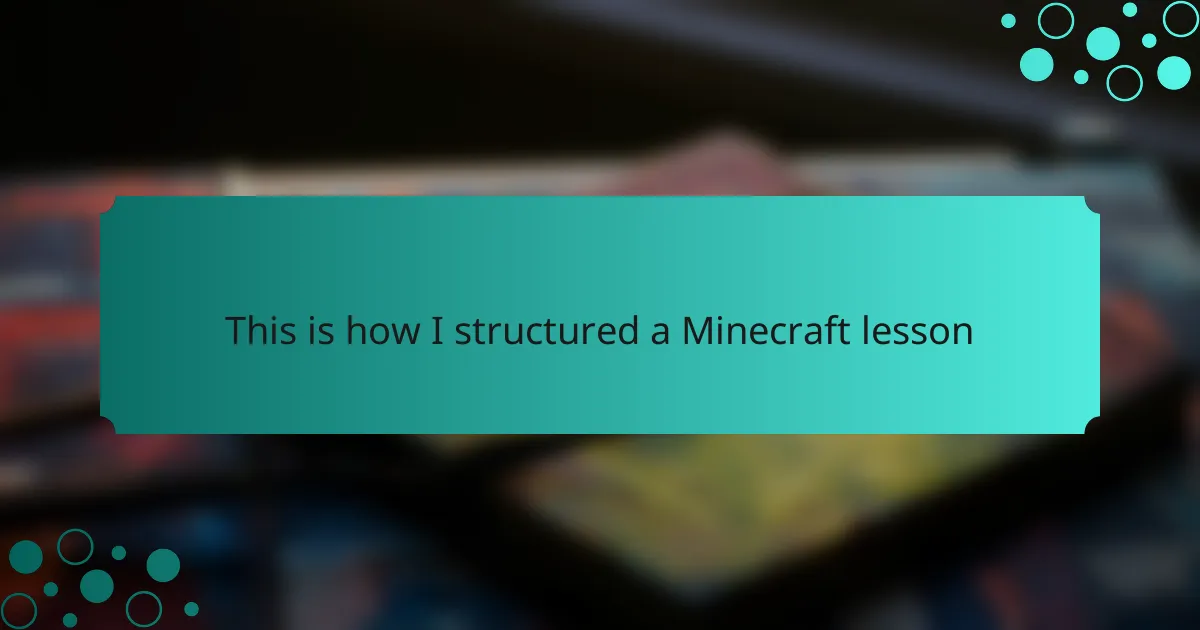Key takeaways
- Minecraft fosters creativity and collaboration, enhancing students’ engagement in learning fundamental concepts like coding and problem-solving.
- Structured lessons are crucial for clarity, focus, and effective learning outcomes, helping students feel secure and engaged.
- Incorporating real-world applications and interactive activities keeps students motivated and allows them to see the relevance of their learning.
- Regular reflection on lesson effectiveness is essential for improving teaching strategies and ensuring student engagement and understanding.
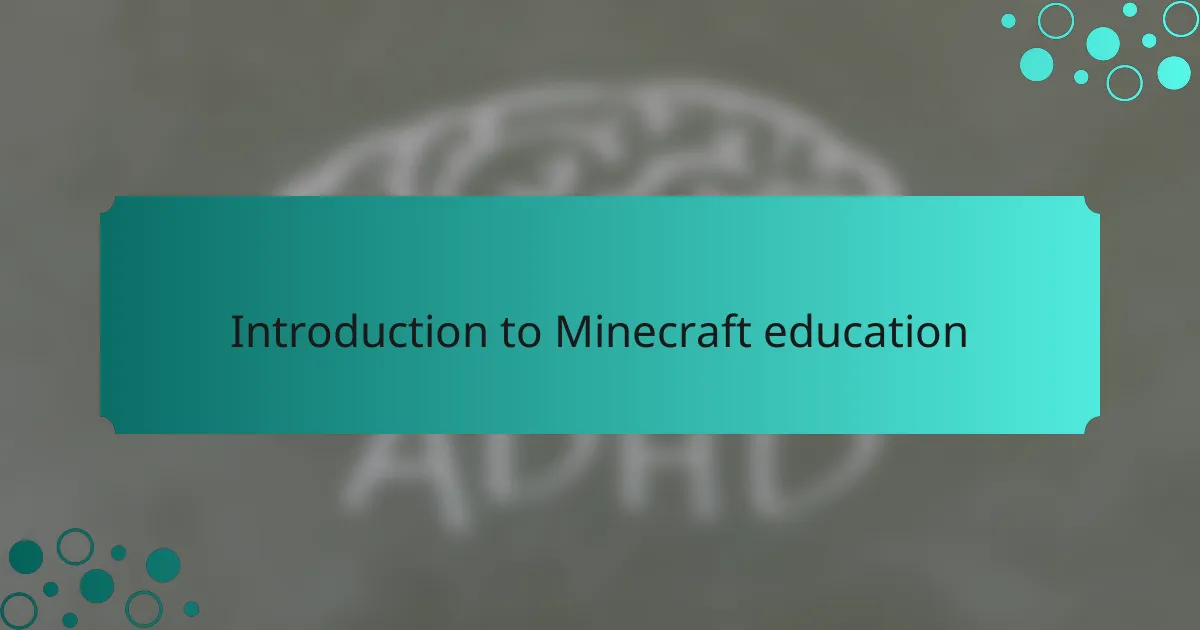
Introduction to Minecraft education
Minecraft is more than just a game; it’s a powerful educational tool that fosters creativity and collaboration among students. I remember the first time I introduced it to my class; their eyes lit up with excitement as they realized they could build anything they imagined while learning vital concepts in programming and problem-solving. Seeing students work together, share ideas, and problem-solve challenges in such a fun environment truly reinforced my belief in the game’s educational potential.
In my experience, the hands-on nature of Minecraft allows students to grasp complex subjects like coding and logic through a familiar and enjoyable medium. The immersive world encourages exploration and teamwork, making learning feel less like a chore and more like an adventure. Here are some key benefits of using Minecraft in education:
- Encourages creativity and critical thinking
- Promotes teamwork and communication skills
- Develops problem-solving abilities
- Engages students with interactive learning
- Supports various learning styles and paces
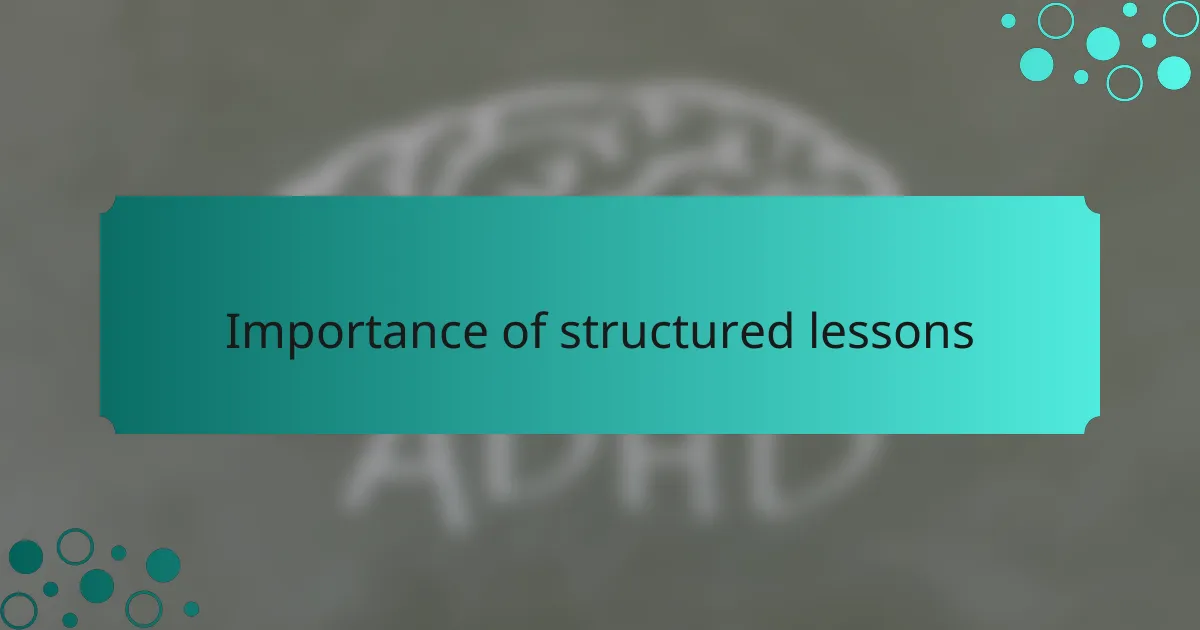
Importance of structured lessons
Structured lessons play a vital role in ensuring that both teachers and students have a clear path to follow. I recall a time when I was experimenting with a Minecraft lesson, and I quickly realized that without a solid structure, chaos ensued in the classroom. Having a well-defined lesson plan not only kept me organized but also helped students feel more secure in their learning environment.
Additionally, structured lessons promote effective learning outcomes and maintain engagement. When I’ve integrated clear objectives and engaging activities into my Minecraft lessons, I’ve seen my students dive deeper into concepts like coding and problem-solving. Here are some key reasons why structured lessons are essential:
- Clarity: Students understand what to expect and can prepare accordingly.
- Focus: A defined structure minimizes distractions, allowing for productive learning.
- Progress Tracking: Structured lessons make it easier to assess student understanding and adjust in real time.
- Engagement: Clear lesson flow keeps students interested and motivated.
- Consistency: A structured approach provides a dependable framework for both diverse learning styles and varied classroom situations.
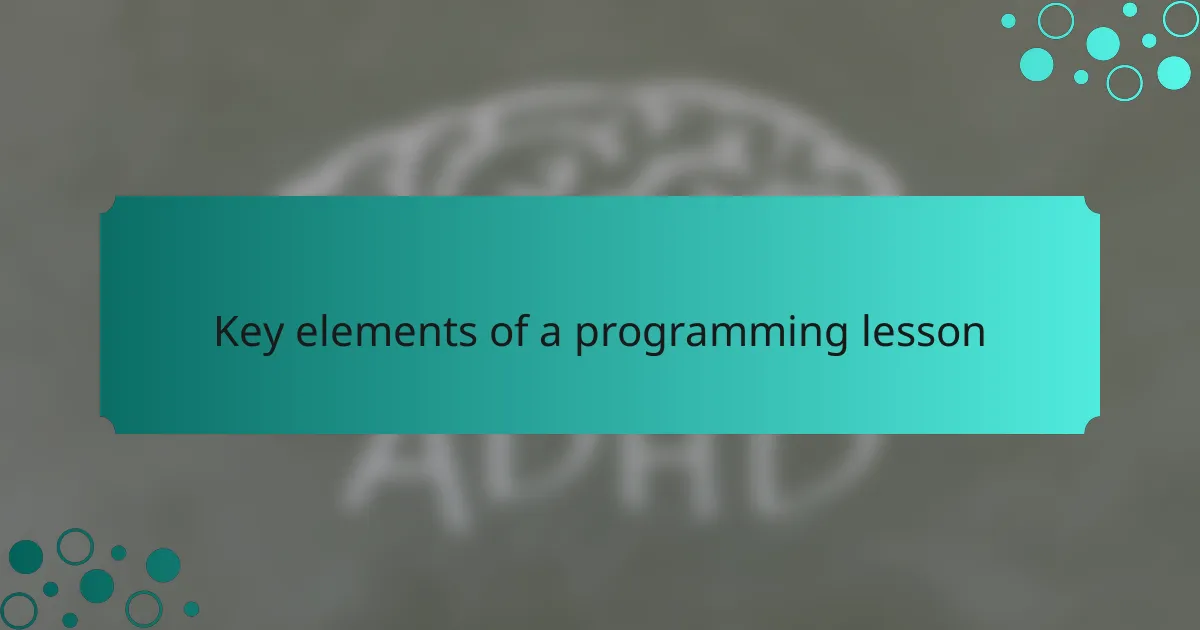
Key elements of a programming lesson
When structuring a programming lesson, particularly in a hands-on environment like Minecraft, I find it essential to include key elements such as clear objectives, interactive activities, and opportunities for feedback. For instance, I remember a lesson where I set specific goals about building logic gates. This clarity helped students stay focused and motivated. Additionally, I always make room for group discussions. These conversations ignite creativity and allow students to learn from each other, which I believe is crucial in a collaborative setting.
I’ve discovered that incorporating real-world applications into the lesson can enhance engagement. When students see how the skills they’re learning apply to their projects or future endeavors, it sparks their curiosity. Reflecting on my experiences, I’ve seen students’ eyes light up when they realize they can create complex systems in Minecraft that mirror real coding concepts.
| Key Element | Description |
|---|---|
| Clear Objectives | Specific goals to guide the lesson |
| Interactive Activities | Hands-on tasks to solidify understanding |
| Feedback Opportunities | Ways for students to reflect on their learning |
| Real-World Applications | Examples to show relevance and usefulness |
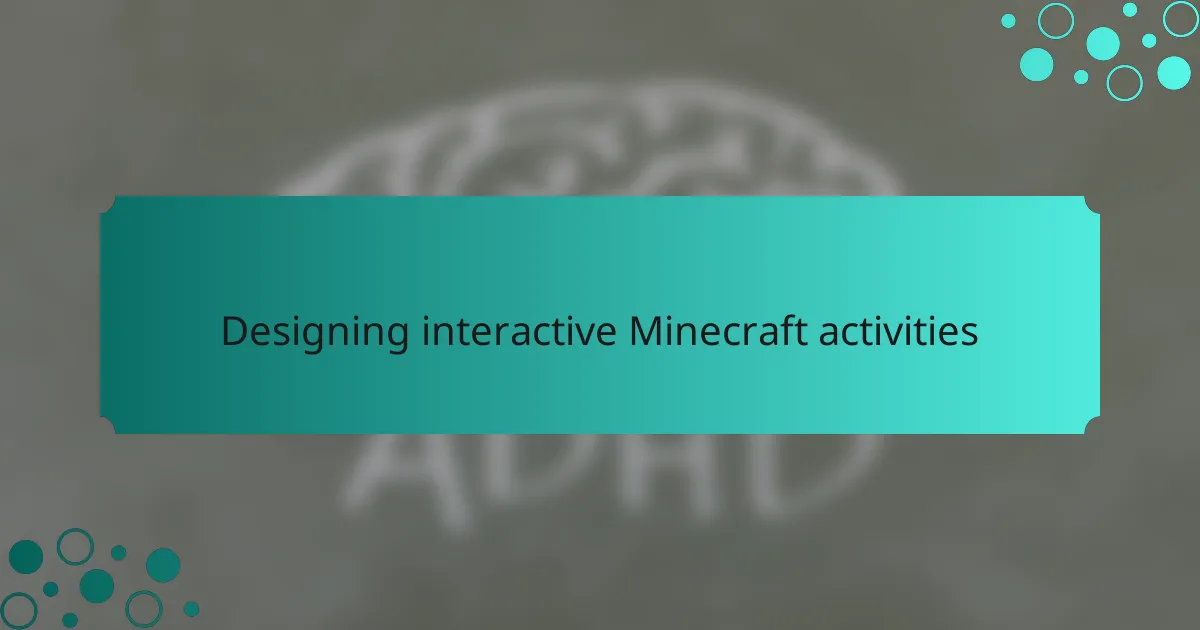
Designing interactive Minecraft activities
Designing interactive Minecraft activities can be an immensely rewarding experience. I remember when I first introduced Minecraft to my students; their excitement was palpable. This platform offers endless possibilities for creativity and learning, making it the perfect environment for engaging students in programming concepts. One of my favorite activities was creating a scavenger hunt, which not only kept them busy but also required them to use problem-solving skills to complete tasks in the game.
When designing your activities, consider incorporating tasks that require collaboration. For example, I’ve had groups work together to build specific structures or identify programming blocks that serve unique functions. This not only fosters teamwork but also allows students to learn from one another, transforming the lesson into a vibrant and interactive experience.
| Activity Type | Benefits |
|---|---|
| Scavenger Hunt | Encourages exploration and critical thinking |
| Collaborative Build | Fosters teamwork and creativity |
| Programming Challenges | Teaches coding concepts through fun tasks |

Tips for engaging students
Creating a Minecraft lesson that captivates students requires a blend of creativity and strategy. From my experience, setting a specific, relatable goal helps keep their attention. For instance, when I tasked my students with building a replica of their favorite real-world landmark, I saw a noticeable spark in their enthusiasm. They were not just playing a game; they were connected to a project that mattered to them personally.
Engagement also flourishes through collaboration. When students work in teams, they’re not only motivated by their peers but also by the shared sense of achievement. I’ve seen how a simple group challenge can ignite competition and creativity, resulting in remarkable projects. Here are some tips to keep your students engaged:
- Incorporate real-world connections: Relate projects to their interests or current events.
- Use diverse learning styles: Incorporate visuals, music, and hands-on activities in Minecraft.
- Set clear, attainable goals: Make sure students know what they’re working towards.
- Encourage teamwork: Foster collaboration to build communication and social skills.
- Provide constructive feedback: Regular praise and guidance create a supportive environment.
These strategies not only enhance engagement but also foster a love for learning.
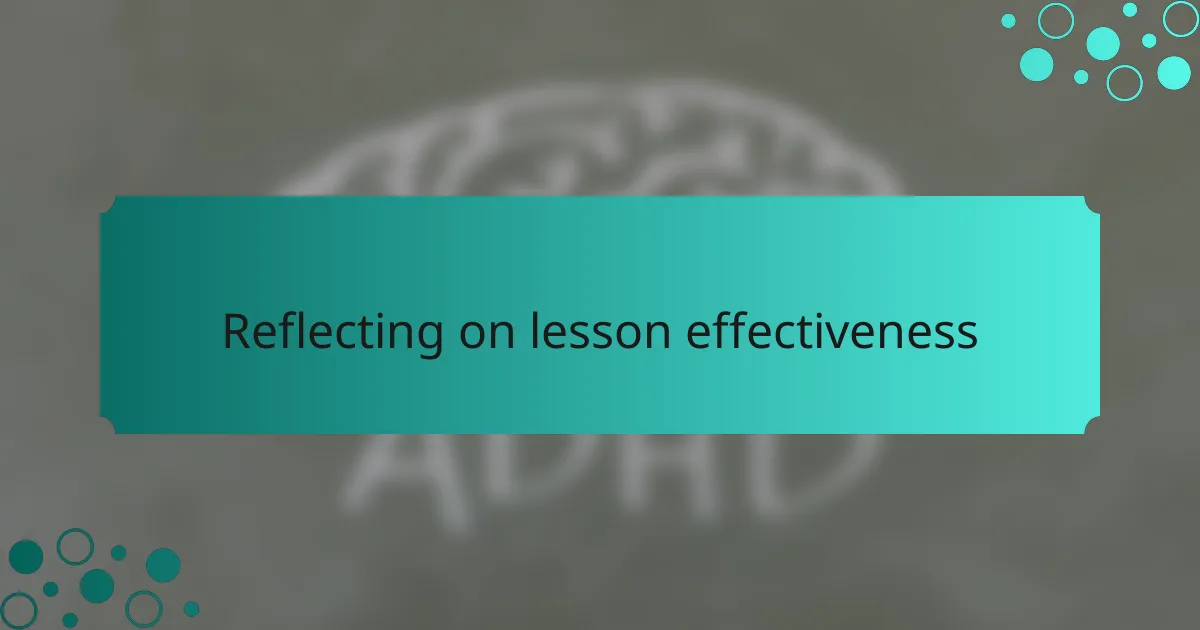
Reflecting on lesson effectiveness
Reflecting on lesson effectiveness is crucial to improving future Minecraft lessons. I’ve often found that after each session, I need to take a moment to evaluate what worked well and what fell flat. For example, during a lesson where students learned to code redstone circuits, I noticed their enthusiasm waned when the task was overly complex. This taught me the importance of balancing challenge with accessibility, ensuring students remain engaged.
When assessing effectiveness, I like to consider various aspects that contribute to a successful lesson. Here’s what I focus on:
- Student Engagement: Were the students excited and actively participating in the lesson?
- Understandability: Did the concepts presented resonate with the students, or did they seem confused?
- Practical Application: Were students able to apply what they learned in creative ways during the lesson?
- Feedback: I always ask students for their thoughts afterward to see what they liked or found challenging.
- Skill Development: Did the lesson contribute to their overall growth in programming and problem-solving within Minecraft?

Personal insights from my experience
When I first started teaching Minecraft as a lesson for programming, I discovered just how engaging it could be for students. Watching their eyes light up as they built intricate structures was truly rewarding. I noticed that when students have the freedom to create, their problem-solving skills flourish.
From my experience, using Minecraft not only makes learning fun but also enhances critical thinking. I remember one student who struggled with traditional coding concepts but thrived in Minecraft, where he could visualize his code in real time. It reshaped my understanding of how interactive environments can boost learning.
Here’s a comparison of key factors that highlight the advantages of using Minecraft in lessons:
| Aspect | Traditional Learning | Minecraft Learning |
|---|---|---|
| Engagement Level | Low | High |
| Collaboration Opportunities | Limited | Extensive |
| Creativity | Restricted | Boundless |
